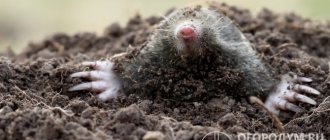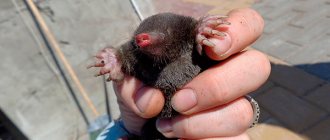Small and invisible moles have acquired the status of almost the most terrible plant destroyer. Animals are mercilessly fought and destroyed in a variety of ways and means. But is the danger so great, is it worth killing these animals? Before getting rid of cute animals, it is worth assessing the benefits and harms of moles. Here are a few myths about harm that are long overdue to be dispelled.
Appearance and structural features
The appearance of this animal very smoothly emerges from the way of life that is characteristic of all their varieties.
This animal is difficult to confuse with some mouse-like rodent, despite some similarities. One look at this miner is enough to understand that the mole is an underground animal. The animal has a very compact body, the length of which usually does not exceed 20 cm, most often less.
It has a very thick cover of upright, short hair, which does not provide resistance to the animal when moving underground. This is very important, because we agree that it would not be easy to move forward in an environment of constant friction with a thick mane.
This soil mammal also has an extremely sensitive olfactory system, despite the fact that its eyes are either completely absent or extremely poorly developed. Some species still have eyes, but they are a reduced organ capable of only distinguishing light from darkness.
Most varieties have no eyes at all, and in their place you can see only small dimples.
The answer to the question of why moles are blind animals can be considered the natural environment that nature has designated for these animals as a home. After all, a mole underground does not need acute vision; it is enough for him to hear and feel vibrations.
And here we can give Mother Nature a “like” instead of a grateful mole, because the burrowing animal has an incredibly sensitive hearing, and was even given the ability to detect ultrasound. This animal is also capable of feeling the slightest vibrations in the soil due to the presence of small vibrissae hairs on its muzzle.
Moreover, moles even have such hairs on the tip of their tail, which allows the animal to move backwards if necessary. Thus, a blind mole “sees” without vision underground no worse than ours on its surface, and its eyes are replaced by other extremely developed organs of smell and touch.
However, these are not all the signs of an underground inhabitant. This animal also has a very digging-like 4 limbs, especially the front two legs, the appearance and structure of which perfectly explain how the mole digs its endless tunnels.
Musteluns
The family Mustelidae (mustelidae) includes species such as badgers and weasels that prey on them. These animals are part of the largest family of carnivores. Many individuals of this species spend the vast majority of their lives underground. They are experienced diggers. They live in holes, which they dig themselves, and often end up in underground tunnels, where they don’t mind hunting.
Badgers and weasels share similar habitats and geographic distributions to moles, and small mammals make up the majority of their diet.
What to do if moles are in the way
The case for animals is often brushed aside. And indeed, as soon as you lose your favorite pear or a meter of raspberries, the benefits and harms of moles fade into the background - you need to get rid of the “guest”. If you have time, you need to wait - after 1-2 years the animal will safely leave to explore new territories.
But if the animal is in the way, consider humane ways to get rid of moles on the site:
- Set up a woodworking machine or play loud music constantly. Animals cannot stand vibrations, so they leave.
- Get a couple of dogs or let children into the garden. The effect is the same - the stomp transmits vibration into the ground, the animals leave.
- Install EcoSniper mole repellers. The best solution out of all of them.
What are mole repellers
EcoSniper sound or vibrosonic mole repellers are devices that generate a wave of sound and vibrations, transmitting them into the soil. The modules look like an ordinary pin, they are installed in the ground in the right place and put into operation. No further actions are required; the mole control tool will do everything on its own.
The main advantage is that all repellers are safe and do not kill animals, but only expel them. Moles do not tolerate vibration or noise; for them, sound is an irritating factor from which they need to get away. Due to the generation of sound and vibrosound waves with different frequencies, the animal will not be able to adapt to the noise or somehow level it out, the mole will have to leave the area once and for all.
The owner of a summer house, garden, or vegetable garden receives a lot of benefits:
- You don’t have to think about how to drive moles out of the area - the repeller will do everything itself.
- The devices do not kill animals or injure them; they are the most humane means of fighting moles.
- Repellers work at any time, including in winter, are autonomous, and easy to operate.
- The devices are harmless to people and pets; no poison, chemicals or toxic substances are used in the work - this is an environmentally friendly and convenient way to expel moles.
To buy EcoSniper mole repellers, call our managers. Specialists will help you select devices based on power, and suggest rules for placement and operation.
Homemade traps
You can make a simple, effective and humane mole trap yourself. To do this, you need to dig up a molehill and dig a container (for example, a bucket or a three-liter jar) under the horizontal tunnel leading to it. It needs to be covered with a board or piece of slate on top - otherwise, when exposed to the light, the mole will suspect something is wrong. You need to pour a little earth at the bottom of the container and put a couple of worms or other food for the mole there - this will work as bait and will not allow him to die of hunger until he is taken out.
Zoologists do not recommend using steel buckets and other containers to catch moles - the animal does not like the smell of metal, it can scare it away.
Ultrasound, daffodils and coffee: 7 humane ways to drive a mole away from your site
Do tubercles of loose soil begin to appear frequently on the surface of your country lawn or in the beds? Most likely, this is the work of a mole. Together with an expert, we found out how to drive away the animal using humane methods and whether it is worth fighting moles at all.
The expert in the article is Anna Bannikova, Doctor of Biological Sciences, senior researcher at the Department of Animal Zoology, Faculty of Biology, Moscow State University, specialist in the field of biology and taxonomy of insectivores and rodents.
The mole is a small animal, 12 to 16 cm long, with dark gray or brown fur. He is almost blind, but has a very sensitive hearing and sense of smell. In Russia you can find the European mole - its habitat extends from Barcelona to Yakutia.
The mole spends most of its life underground - on the surface it is defenseless. With the help of powerful shovel-shaped front paws, moles dig tunnels, which they use for movement and hunting. An animal can dig up to 50 m of such tunnels per day. Moles live in a nest at a depth of about 1–2 m.
Moles mainly feed on earthworms, slugs, caterpillar and beetle larvae, amphibians and small rodents. The bumps on the soil surface that the mole creates (molehills) are traps. The animal leaves musky marks in molehills - their smell attracts worms.
Moles love soft, loose and fertilized soil: it is easier to dig and there is more food in it. Therefore, well-kept vegetable gardens and orchards are the most comfortable habitat for them. But these animals do not touch plants - if bitten vegetables appear in the garden, then most likely this is the work of voles or shrews.
Diet: benefit or harm for humans?
It's time to answer the question of what a mole eats. As already mentioned, the food for these burrowing animals is mainly insects. However, their diet can be somewhat expanded on occasion.
Moles feed on any available animal food. These predators can even feed on small animals such as mice or frogs.
It must be said that this insectivorous predator has a very fast metabolism, and for this reason is quite voracious. Weighing 80-90 grams, many animals of this family are able to absorb up to 140 grams of organic food. You won’t immediately find such gluttons who would eat all day long.
It is also necessary to dispel the myth that these diggers eat vegetables and root crops, spoiling the harvest. This is not entirely true. We have already figured out what a mole eats. Now let's say a few words about the relationship between this animal and man.
The war that man has declared on this animal has been going on for decades, and the reason for it all is that the blind mole digs the ground and, while making its holes, thereby touches roots and tubers.
Also, in pursuit of prey, digging the ground near the root systems of plants, the animals also grab pieces of roots or harvest items, thus falling out of favor with farmers.
Such an animal, which seems to feed on insects, may well significantly reduce the yield of the same nightshades.
At the same time, a blind mole can not only cause harm, but also be beneficial. These animals dig the ground, thus loosening the soil, and thanks to the molehills, air enters and the soil is enriched with oxygen in the depths. This is what benefits moles bring to the soil.
The benefits of moles in the garden
So, the harm of moles is exaggerated, but few know about the benefits of animals. And there is much more harm than harm:
- Soil drainage. The passages and holes of moles are located shallow underground. Long tunnels form a drainage system to remove excess water.
- Providing oxygen. Heaps of soil on the surface are excellent soil for flowers and seedlings. Moles throw out shoveled soil, enriched with fertilizers and oxygen; there is nothing better for plants. Now there will be less reason to think about how to get rid of moles.
- The mole destroys pests throughout the area. For this alone, the animal can be forgiven for the dug up lawn and the dead fruit tree. The underground “assistant” easily deals with mole cricket burrows, beetles, caterpillars and their offspring.
What harm do moles cause?
Seemingly sweet and innocent creatures can bring a lot of problems:
- In addition to insect pests and larvae, the diet of moles includes beneficial soil organisms, such as earthworms.
- Unlike voles, moles dig deep holes. Typically their burrows are at least 25 cm below the surface, except when they are looking for a mate. Check your lawn for these holes (they look like raised, volcano-like piles).
- Through the passages, various pests gain unhindered access to plants, and it becomes more difficult to detect them.
Surface tunnels and long mounds also indicate mole activity.
How moles reproduce
Moles give birth once a year, some species 3 times a year. Moles mate underground, after mating they lose interest in the partner, the males return to their nests, and do not care for the cubs after birth. The mating period is 2-3 days.
The female carries the fetus for 40 days, then gives birth. At one time, a female can give birth to 3 to 9 cubs. After birth, she feeds the cubs with milk. After 20-30 days, the cubs become adults, begin to make their own holes and nests, and as they grow older, young moles become pugnacious and begin to occupy new territories. The female reaches sexual maturity in 1 year; there are species in which this process occurs faster.
Altai mole reproduction breeding features
- Mating occurs from June to early August
- pregnancy lasts about 270 days, such a long period due to diapause (fertilized egg does not develop)
- young individuals are born in April-May of the following year
- litter of 3-6 cubs
- sexual maturity in the 2nd year of life, females - in the 1st year of life
Preventive measures
Several steps to prevent mole infestations in your garden will help solve the upcoming problem before it arises:
- Check the soil for the presence of pests: if there are a lot of moles, then there is an excess of larvae and beetles in the ground. Try spraying the area with milk spores or beneficial nematodes to get rid of the larvae. The same remedy helps against the Japanese beetle.
- If you want to protect a specific plant, dig a hole about a meter deep and line the walls with chicken wire. After this, fill the hole with soil containing the seedling.
- Plant plants that moles do not like. These include marigolds, marigolds, castor plants, garlic and onions.
Moles are often blamed for damage caused by field mice due to their external similarity.
When starting the fight against moles in the garden, remember that these animals also have a useful function, destroying harmful insects and slugs. If underground animals have begun to seriously damage your property, try not to harm them, but to catch them using humane means and release them in rural areas several kilometers from home.
How moles winter
The mole does not hibernate in winter; it spends the winter in the same area as the summer. Sometimes the crown makes forays into the leaves under the snow cover, this allows it to feed on insects that overwinter in the thickness of the leaves. For the winter, the mole stores insects on which it feeds; in winter, it is more difficult for the mole to find food for itself. If a mouse dies in the mole's passages, the mole can feast on it. In winter, the mole sleeps longer than in summer, this allows him to save vitality.
A pet with a bad temperament
This stuffed animal has a bad character - quarrelsome and irreconcilable. The mole is a bloodthirsty, irreconcilable and aggressive creature ; it can even eat a small mouse that accidentally gets into its home.
He does not tolerate neighbors, he will not eat another mole, but he will greet him extremely unfriendly. Moles come together in pairs only during the breeding season. By the way, they reproduce quite quickly. And he doesn’t have time for friendship, because the mole is always busy with his own food. Spending a colossal amount of energy on digging, he is forced to eat from 70 to 100% of his weight. The mole's entire life passes underground; as they say, he “does not see the white light.” Although among the representatives of this species there are those that go outside or lead a completely terrestrial lifestyle.
Some even keep a mole as a pet, however, moles are not very loving. The main thing is to feed your home mole correctly, since plant foods are not suitable for him. If you have already caught this animal and decided to place it in your home, then be prepared to now catch grasshoppers and dig for worms, without which it cannot live.
Skunk
Most species of skunks live in the same regions that moles live. Therefore, the latter often become prey for the former.
We recommend reading: “Who eats mice?”
Although skunks are omnivores, meat still makes up the majority of their diet. These nocturnal creatures spend the vast majority of their time in their lair, digging tunnels in search of prey.











